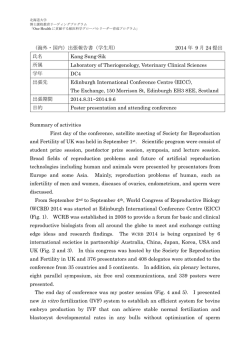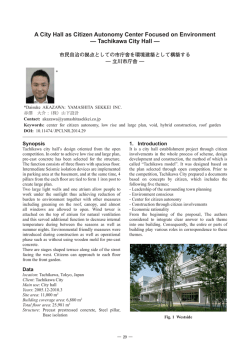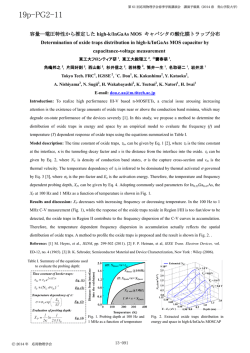
On the Comparison Between Two-seam Trawl Net and Four-seam
NAOSITE: Nagasaki University's Academic Output SITE Title On the Comparison Between Two-seam Trawl Net and Four-seam Trawl Net Author(s) Flores, Efren Ed.C.; Nakasai, Kei Citation 長崎大学水産学部研究報告, v.32, pp.129-134; 1971 Issue Date 1971-12 URL http://hdl.handle.net/10069/31092 Right This document is downloaded at: 2015-02-01T00:17:54Z http://naosite.lb.nagasaki-u.ac.jp 129 On the Comparison Between Two-seam and Four-seam Efren Ed. Models of two-seam be identical The trawl FLORES and in a circulating Net Net Kei net and four-seam in size and tested mechanical elevation C. Trawl Trawl NAKASAI trawl net type water were constructed tank to compare to their characteristics. results of the of headline, important spread net to be more efficient working performance of wings and total than the two-seam of the resistance, nets, such as showed the four-seam net. Introduction In Japan, construction Europe until lately, the into two types—the at the originated beginning trawl nets were two-seam trawl of the century, and classified net which the according was four-seam to introduced trawl net the from which in Japan. The two-seam in two-boat trawl net was employed trawling. Though in the same fishing ground, in otter the fishing trawling and methods differed, i. e. , the East China Sea. the four-seam both were operated Thus the two types of nets were to catch the same group of fishes, however, has been given as to why two different of nets had to be used for operation in the same area. The mechanical types difference between no specific explaination the two types of nets was not clear and therefore it could not be used to explain the above matter. It is then they local considered that were constructed and operated following conventions. Up to the present, overseas fishing in the seas adjacent is otter trawling, trawling to Japan. that the of fishing operations have been expanding to since the World War II due to the decrease of fish catch Although the net construction It is considered experiences the Japanese grounds the method of operation has shifted employment operations of the and not for to the gear of these trawlers four-seam trawl net. is based on the long-term its advantages due to mechanical mechanical character- characteristics. Presently, there istics of the trawl the relationship is not much study on the comparative nets. between N. NOMURA and T. YASUI1) conducted the resistance and trawl, 2) Danish seine commonly used waters, 3) two boat type trawl generally towing in the speed of north-eastern operated in the 1) ordinary area East a study on otter of Japanese China Sea, 4) 130 Bull. Fac. Fish., Nagasaki Univ., No. 32 (1971) Japanese type small trawl operated manually and 5) Japanese type small otter trawl, using their respective model nets. However, each net was treated indepen− dently, i. e., the models were of different size. lt is difficult to construct model nets of different construction but of similar size if they are based on specific full scale nets such as those mentioned above. In this respect, the comparative study on the mechanical characteristics of several fishing nets of different construction but of one type such as trawl nets, is best approached by using theoretical analysis based only on the mode of Qperation and the geometrical configuration of the net in operation. From this, model nets of similar size but of different construction (i.e., 2, 4, 6−seam nets) could be made. This approach gives accurate comparison of various aspects of the model net such as elevation of the net modth, spread of wings and resistance. Furthermore, the construction of model net is not restricted by the size of a full scale net since such need not be taken into consideration. On the contrary, an efficient full scale net can be made using the results of the model net test. T. TANIGUCHI2) investigated the resistance of four types of cod ends of similar size, i. e., 1) parabolic cylinder type, 2)i sphenic type, 3),., pyramid type and 4) box−type, on’the basis of theoretical+analysis, a similar approach to the above mentioned method but limited only to cod ends. Therefore, to understand fully the mechanical differences between two types of net construction, the authors attempted in this report to compare the mechanical characteristics of two−seam and four−seam trawl nets statting with the theoretical analysis and then experimentally investigating their models of identical size and materials . Analytical studies on the mechanical characteristics of the four−seam・trawl net were made by T. KAWAKAMI and K. NAKASAI3,4). A study on the same of the two−seam trawl net was done by the authors in a separate paper5) using the same treatment as mentioned above. Expenses for executing this study were partly defrayed by the Japanese Ministry of Education. Experiment For accurate comparison of the mechanical characteristics between the two− seam trawl net and the four−seam trawl net, their model nets were constructed in identical size, i, e., the mesh area being the same in all sections. The only difference consists in the manner of construction as shown in Fig. 1. The seaming line of the two−seam net starts from the end of the wing passing through its center down to the edges of baiting and belly, then to the cod end. For the four−seam net, the seaming line starts from the headline between the joints of square and side wall, then down to the body and cod end. Another seaming line 131 E. FLoREs and K. NAKAsAI : Comparison of Trawl Nets ピ 2−Searn 一N 2 N2一 囲 N2 ’/・、髄5 B創丁醜’ ・. コ ロ し 玉 囲一 らし N2’・、亀 2 1 KZ B しY b N2 1N 4−Seqm N2 COD END 匡]国国 i・亀 N2 ,二 N ほ 巨][ヨ国回国 由 SQUIIiRE N2 s . VLDER WING 匹]国 E灯. WIN Fig. 1. Experimental model nets. runs from the groundline between the joints of side wall and belly, then down to the cod end. The dipaensions of the model nets and the experimental procedure are the same as those in the previous paper5). The two model nets were tested in the same circulating type water tank maintaining the same conditions to get a good accuracy of their comparison. Comparisons were made on elevation of headline, spread of headline, sectional horizontal spreads and resistance. Result and Discussion Since the important working performance of the net is characterized by the horizontal spread, elevation of headline and resistance, the comparisons were concentrated on these aspects. Fig. 2−A shows the sectional horizontal spread of headline; 1) y. spread at extension wing of Ni webbing, 2) y.. spread at wing of N 2 webbing and 3) yh spread at square, for beam length of 20cm at different water velocities. At y ev, the four−seam net has a wider spread than the two−seam net both maintaining a constant spread throughout. Spread orww shows the same relation− ship except for the 10−20 cm/sec velocity range where the four−seam net shows a decreasing change. However, yh gives a change in relationship with the four− seam net having a lesser sptead than the two−seam and is maintained throughout. 132 Bull. Fac. Fish., Nagasaki Univ., No. 32 (1971) ㎝ε yh 5 一 2 Seam 少 _一4Seom 3 、 、 、 、 、 、 、 一 一 @ 噛、㌔ 一___ ___ ____一一一一一 y” 2 yw ______ __一一 一一一 一一一一 一一 一一一一 一 一一一 一 一. Io 50 20 30 40 @ V{Gm18GC, Fig.2・A. Sectional horizontal spread of headline at extension wing(yw), wing (yww)and square(yh)for two・seam and four・seam trawl nets in relation to water velocity(V)at 20cm beam length. The total spread of the headline shows that both nets have the same value. However, at this beam length, the elevation of net month, Z, of the four−seam net is higher than that of the two−seam net from about 25 cm/sec water velocity as shown in Fig. 3. This may be attributed to the spread relationship at pth. Fig. 2−B shows the same sectional’ horizontal spread of the headline at beam length of 35cm. Both y. and y.w fluctuate more than those of Fig. 2−A with the change of water velocity, and yh presents the same result as in the previous beam, length except for a slight increase in difference as water velocity increases. 乙., \ \\ \ \\ 3.0 \ 、 \ \ \ \ \ \ \ \ \ \ \ 、、 \ \ N \ N \ \ \ \; \ 、 ヘミ \ \、 2.0 \ 、 \ 、 \ 、 \ 、、 、 、、 \ 、 \ \ \ 、、 、 、 、 、 、 、 、 、 、 1.O s 一. 一一一一一一一一20 一’ @.一一N. 、 、 \ 、 、 、 、 、 、 、 .一 35 20 N 35 50 、 50 Vl㎝ノ8ec) IO 20 50 40 Fig. 3. Observed values of elevation of headline (Z) for two−seam and four− seam nets in relation to water velocity (V) at 20, 35, 50cm beam lengths. 133 E. FLoREs and K. NAKAsAI : Comparison of Trawl Nets m.. C8叩 ”一一一一 一『一、』一一一一一__一 yh 一. @g 一.. 一一 一一 N 一一一 7 5 一一一一一一一 ’Yww t t .一一 一一 一一 pt 一一一・一 2 Seam 一一一 4 Seqrn 4 〈一一 一一一一一.一一. Yw s tO 2b v(cmJsec) 50 40 50. Fig. 2−B. Sectional horizontal spread of headline at extention wing (yw), wing (yww) and square (yh) for two−seam and four−seam trawl nets in relation to water velocity (V) at 35 cm beam length. Referring back to Fig. 3, Z of the four−seam net is still higher than that of the two−seam net. In Fig. 2−C at 50 cm beam length, the change in horizontal spread is noti− ceable, For yw and yww, the four−seam net has lesser spread than the two−seam net. However, at 30cm/sec water velocity, the wings of the two−seam net collapsed showing the instability of the net at higher velocities. Even with the same yh for both nets, the Z value is higher with the four− seam net than with the two−seam net. Since the number of floats and the size C揃 9 =一 Yh 8 一 一 一 一 一 一 一 一一 一 一 一 .一一一 一 一 一 一 一 一m一 一 一“ N N N− N し SN YWW 7 一 2 Seam 6 一一一 @4 Seam 、 、 、 、 !! y W 、 、 ∼ ヘ ノ 、 、 _ _ _ _ _ 一 ’ IO 20 50 40 50 V(cm/sec) Fig. 2−C, Sectional horizontal spread of headline at extension wing (yw), wing (yww) and square (yh) for two−seam and four−seam trawl nets in relation to water velocity (V) at 50 cm beam length. 134 Bull. Fac. Fish., Nagasaki Univ., No. 32 (1971) and kind of webbing are the same in both nets, these can not be the cause of the difference in headline elevation. The only one aspect left out 一to affect the elevation of the headline is the construction of the net at square, body and sides. The force acting on the side wall of the four−seam net is transmitted to the ribline where the seaming line is stapled. For the two−seam net, the upper section of the side wall is a part of the baiting and one half of its resistance is transmitted to the latter. Since the forward section of the baiting (square) is, stapled to the headline, its resistance affects the headline elevation as explained in the previous paper5). The observed values of the towing forces (f−fW, F−fWr) or total resistance of the nets do not show any difference, although 15 in the theoretical values, the two−seam e 一2 Seam net shows a greater resistance than the ●一一}一4Seoゆ ● / / Z ● for the different types of cod ends o ● remains the same. This was also true eo●●・● to O ㌔f irrespective of construction, the resistance OO 下 range as shown in Fig. 4. Therefore, 謹 four−seam net within the ekperimental investigated by T. TANIGUCHI 2) . Based on the above results, both 一 5 卸/ / ! / calculated and observed values proved that the four−seam net is mechanically more efficient than the two−seam net・ IO 20 30 40 50 ew.β獅 Fig. 4. Observed (O, e) and calculated (., ・・・…) values of towing forces of two−seam net(fw/f)and four−seam net (Fw/F) in relation ’to respective angle of force (Bw) and (ew). Reference 1) NoMuRA, M. arid T. YAsul: Model experiments on trawl nets of various types, Bull. Jap. Soc. Sci. Rish., 18, (12) , 727−733 (1953) 2) TANIGucHI, T. : On the resistance Of various cod ends fixed in a stream 一1, Bntt. Jap. Soc. Sci. Fish., 21, (5), 29!−296 (1955) 3) KAwAKAMI, T. and K. NAKASAI : On the mechanical chara’cter of the drag n.et−li, Bugl. Jap. Soc. Sci. Fish., 28, (7), 644−670 (1962) 4) KAWAKAMI, T.’ and K. NAKAsAI : Theoretical derivation of characteristic curve of trawl nets, Mem. Colt. Agr. Kyoto Llniv., No. 94, (Fish. Ser. No. 9), 1−16 (1968) 5) NAKAsAI, K.,and E. FLoREs : Theoretical studies on the mechanical characteristics of two−seam trawl net, This Bul.t., 32, 113−128 (1971)
© Copyright 2026



